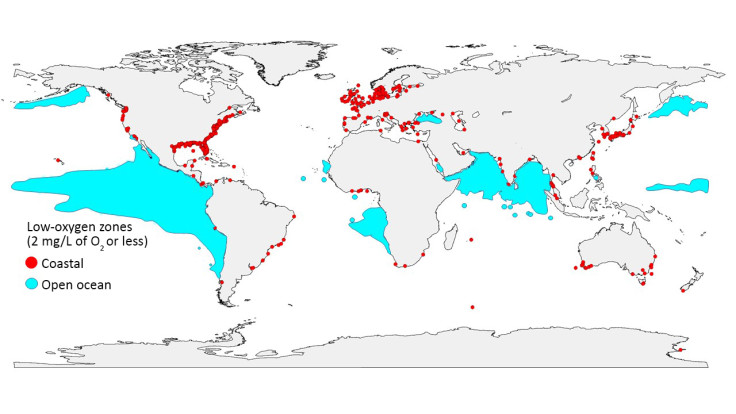What are 'dead zones'? Volume of oxygen-deprived water in oceans has quadrupled in the past 50 years
In a study, researchers have found that "dead zones" will only continue to expand in volume as the planet gets warmer.
The amount of water in the open ocean with zero oxygen has gone up by four times in the past 50 years because of global warming and changing climate change. And in coastal waters, sites with low oxygen have gone up tenfold since 1950.
In a study that the Smithsonian Environmental Research Center (SERC) is calling the "broadest view yet of world's low oxygen", researchers have found that "dead zones"—spots in the ocean that have no oxygen—will only continue to expand in volume as the planet gets warmer with each passing year.
"Oxygen is fundamental to life in the oceans," said Denise Breitburg, lead author and marine ecologist with the SERC. "The decline in ocean oxygen ranks among the most serious effects of human activities on the Earth's environment."
The study was carried out by a team of scientists at the Global Ocean Oxygen Network (GO2NE) which was set up in 2016 by UN's Intergovernmental Oceanographic Commission. It is the first paper that takes a look at the causes and consequences to low oceanic oxygen levels in the world's open ocean and coastal waters. The paper has also offered certain solutions to reduce the growth of these dead zones.
Apart from its obvious effects on marine life, the researchers stress why this finding is alarming, is because "approximately half of the oxygen on Earth comes from the ocean."
"However, combined effects of nutrient loading and climate change are greatly increasing the number and size of 'dead zones' in the open ocean and coastal waters, where oxygen is too low to support most marine life." said Vladimir Ryabinin, executive secretary of the Intergovernmental Oceanographic Commission that formed the GO2NE group.

The regions that have been traditionally known as dead zones, oxygen levels can drop to levels so low that fish will actually suffocate under water and die. The report mentions the Chesapeake Bay and the Gulf of Mexico as prime examples. Fish tend to avoid such regions and this shrinks their habitat, leaving them open to attack from predators and over-fishing.
In regions that have low oxygen, and are not entirely dead, the report points out that marine life in these regions is vulnerable to stunted growth, hindered reproduction, disease, and eventually death. The report BY SERC does mention that while there are certain forms of life that can thrive in these conditions, the overall biodiversity of these regions has been found to plummet.
Low oxygen also leads to the release of deadly gases in the waters like hydrogen sulphide, notes the report. Another dangerous gas that is likely to get triggered is the nitrous oxide which is 300 times more powerful as a greenhouse gas than carbon dioxide.
As to why this happening, the report explains that in open waters, warmer oceans make it harder for oxygen to go deeper. Also, warmer water simply tends to hold less oxygen. On the other hand, coastal waters are losing their oxygen because of pollution and run off into the seas creates algal blooms that form a blanket over the water, slowly draining the gas from beneath it as they die and decompose.
"This is a problem we can solve," Breitburg said, adding that climate change is something that has to be worked on in a global scale. "Tackling climate change may seem more daunting, but doing it is critical for stemming the decline of oxygen in our oceans, and for nearly every aspect of life on our planet."





















